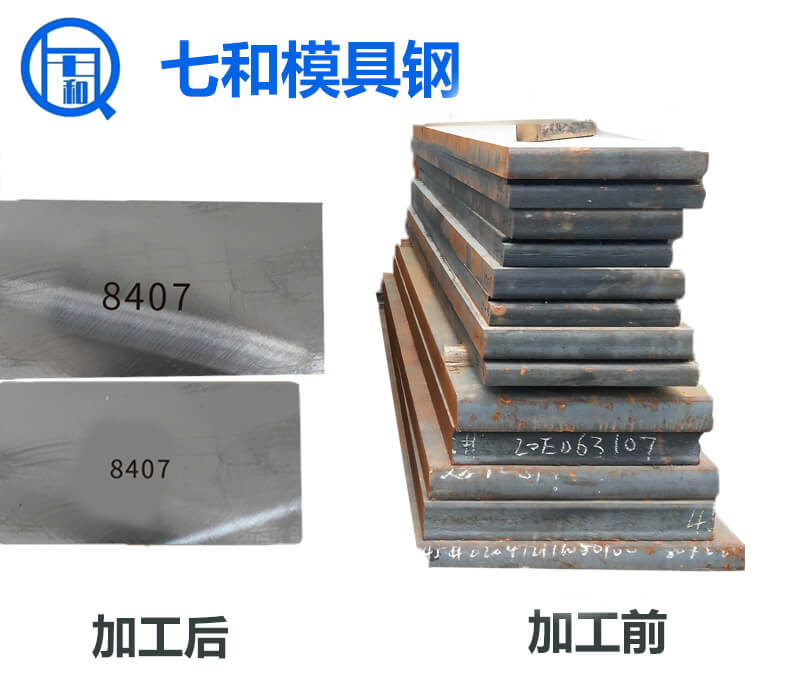为了提高模具钢耐磨性一般都要进行淬火处理。 而所谓钢的热处理就是将钢在固态范围内施以不同的加热,保温和冷却,以改变其性能的一种工艺。今天小编就为大家介绍一下淬火对模具钢有什么影响?

In order to improve the wear resistance of die steel, quenching treatment is usually carried out. The so-called heat treatment of steel is a process of applying different heating, heat preservation and cooling in the solid range to change its performance. Today, I'd like to introduce the effect of quenching on die steel?
一、模具钢分级淬火法
1、 Step quenching method for die steel
将加热到奥氏体化温度的模具钢或工件淬入温度在马氏体转变温度附近的冷却介质(常用的为盐浴)中,停留一段时间,使工件表面和中心温度逐渐趋于一致后取出空冷,以较低的冷却速度完成马氏体转变,此法能显著减少变形并且提高模具钢的韧度,是模具零件常用的淬火方法之一。模具钢分级淬火的温度选择有两种。一种是取被处理工件钢种的马氏转变开始温度(ms点)以上10~30℃;另一种是选取ms点以下80~100℃。分级的停留时间也要掌握好,过短则温度不够均匀,未能达到分级淬火的目的;过长则可能发生非马氏体相变而降低硬度。
The die steel or workpiece heated to austenitizing temperature is quenched in the cooling medium (commonly used as salt bath) near the martensitic transformation temperature for a period of time, so that the surface and center temperature of the workpiece are gradually consistent, and then the workpiece is taken out for air cooling, and the martensitic transformation is completed at a lower cooling rate. This method can significantly reduce the deformation and improve the toughness of the die steel, which is a common method for die parts It is one of the best quenching methods. There are two kinds of temperature selection for step quenching of die steel. One is to select 10 ~ 30 ℃ above the start temperature of martensite transformation (MS point) of the steel grade to be treated; the other is to select 80 ~ 100 ℃ below the MS point. If the residence time of grading is too short, the temperature is not uniform enough and the purpose of grading quenching can not be achieved; if it is too long, non martensitic transformation may occur and the hardness may be reduced.

二、模具钢等温淬火法
2、 Isothermal quenching of die steel
将加热到奥氏体化温度的模具钢工件淬入温度稍高于被淬火钢钢种ms点的热浴中等温停留,完成相变以获得下贝氏体组织或下贝氏体和马氏体混合组织。此法目的有缓解变形和开裂,淬火应力小等优点。具有与回火马氏体相近的强度和韧度
The die steel workpiece heated to austenitizing temperature is quenched into a hot bath with a temperature slightly higher than MS point of the quenched steel, and the transformation is completed to obtain the lower bainite structure or the mixed structure of lower bainite and martensite. The purpose of this method is to relieve deformation and cracking and to reduce quenching stress. It has similar strength and toughness to tempered martensite
三、模具钢单液淬火法
3、 Single liquid quenching of die steel
将模具钢或零件加热到奥氏体化后淬入水,油或其他冷却介质中,经过一定时间冷却(冷却到低于珠光体型转变温度区域或马氏体转变温度区域)取出模具钢空冷。由于模具钢冷却过程在单一冷却介质中完成的,称单液淬火法。
The die steel or parts are heated to austenitizing and then quenched into water, oil or other cooling medium. After a certain period of cooling (cooling to the region below pearlite transformation temperature or martensite transformation temperature), the die steel is taken out for air cooling. Because the cooling process of die steel is completed in a single cooling medium, it is called single liquid quenching method.
四、模具钢双液淬火法
4、 Double liquid quenching of die steel
顾名思义,模具钢淬火冷却过程是在两种冷却介质(常用的是水,油)中配合完成的。使冷却过程较为理想,既在珠光体转变区域快速冷却,在马氏体转变区域缓慢冷却.具体做法是,将加热到奥氏体化温度的模具钢或零件先淬入高温区快冷的种介质中(通常是水或盐水溶液),以抑制过冷奥氏体的珠光体转变,当冷却到00℃。左右时,迅速取出转入低温区缓冷的第二种介质中(通常为油)。由于马氏体转变在较缓和的冷却条件下进行,可有效地缓解或防止变形和开裂,俗称水淬油冷。此法需要较高的操作技巧。有时了理解为三种介质,即先水,后油,终是空气。
As the name suggests, the quenching and cooling process of die steel is completed in two kinds of cooling media (the most commonly used are water and oil). In order to make the cooling process more ideal, rapid cooling in the pearlite transformation region and slow cooling in the martensite transformation region. The specific method is to quench the die steel or parts heated to the austenitizing temperature into the first medium (usually water or salt water solution) of rapid cooling in the high temperature region, so as to inhibit the pearlite transformation of undercooled austenite. When the temperature is about 30 ℃, it is quickly taken out and transferred to the second medium (usually oil) with slow cooling in the low temperature zone. As martensite transformation is carried out under mild cooling conditions, it can effectively alleviate or prevent deformation and cracking, commonly known as water quenching and oil cooling. This method needs high skill. Sometimes it is understood as three kinds of media, that is, water first, then oil, and finally air.
五、模具钢喷射淬火法
5、 Spray quenching of die steel
大型复杂特别是厚薄差大的工件和模具钢,为使冷却均匀避免过大的淬火应力,控制好冷却过程不同阶段不同部位的冷速的方法。有喷液(水或水溶液),喷雾(压缩空气和水经雾化喷射到零件不同部位),气淬等多种方式,其优点是可控制不同介质或不同流量,压力来控制和调节各温度区域的冷速;或改变不同喷嘴数量和位置可使;冷却均匀。目前在模具热处理中的真空高压气淬即是。
For large and complex workpieces and die steel with large thickness difference, in order to make the cooling uniform and avoid excessive quenching stress, it is necessary to control the cooling rate of different parts at different stages of the cooling process. There are spray liquid (water or water solution), spray (compressed air and water through atomization to different parts of the parts), gas quenching and other ways, the advantage is that it can control different media or different flow, pressure to control and adjust the temperature of each region of the cooling rate; or change the number and location of different nozzles can make cooling uniform. At present, the most popular vacuum high-pressure gas quenching in mold heat treatment is.
上一条:
山东模具钢的温度如何正确的掌握?
下一条:
塑料模具钢的特性有哪些?




















